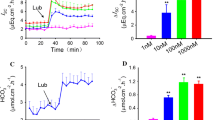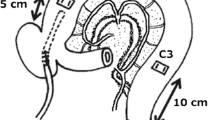Summary
The influence of four opioid antagonists on short circuit current (Isc), transepithelial potential difference (Pdo) and tissue conductance (Gt) in the guinea pig colonic mucosa was investigated in vitro under both basal and PGE1 plus theophylline-stimulated conditions. The experiments aimed at identifying the opioid receptor type(s) endogenously activated to control chloride secretion.
Under blockade of sodium-dependent Isc by amiloride (100 µmol/I), net anion secretion was regarded to equal the lumen-negative shift in Isc upon addition of 1 µmol/l PGE1 plus 100 gmol/l theophylline. It was significantly elevated by 100 nmol/l of the ϰ-selective antagonist nor-binaltorphimine (nor-BNI). This augmenting effect was totally abolished in amiloride-free buffer or by omission of chloride. 1 µmol/l TTX completely prevented the effect of both PGE1 plus theophylline and nor-BNI. Both the ϰ agonist U 69593 (10 nmol/l) and the calcium channel agonist Bay K 8644 (1 µmol/l) significantly depressed net anion secretion stimulated by PGE1 plus theophylline. Nor-BNI at 10 nmol/l prevented the suppressive effect of both Bay K 8644 and U 69593. This suggests release of endogenous opioids by the calcium channel agonist Bay K 8644 and competition between the ϰ agonist U 69593 and the ϰ antagonist nor-BNI. In contrast to the ϰ antagonist nor-BNI, the µ antagonist CTOP-NH2 at 100 nmol/l significantly impaired, while the µ-selective agonist DAGO at 0.2 nmol/l augmented, net anion secretion stimulated by PGE1 plus theophylline. The effect of CTOP-NHn2 was abolished in chloride-free buffer. The δ selective antagonist ICI 174.864 (up to 1 µmol/l) and the non-selective antagonist naloxone (up to 1 µmol/l) failed to influence stimulated net anion secretion. The failure of naloxone may be due to superimposition of the contrasting effects of µ and ϰ receptor blockade by a high naloxone concentration.
The antagonist effect of nor-BNI considered above was obtained at 9.6 nmol/l potassium but was no longer observed when the potassium concentration in the bathing solution was reduced to 4.8 mmol/l. It is suggested that both elevated potassium concentration and calcium channel activation by Bay K 8644 release endogenous ϰ agonists in the guinea pig colonic mucosa under the present conditions. Since CTOP-NH2 impaired stimulated net anion secretion at both of the potassium concentrations, release of endogenous µ agonists and, hence, activation of µ opioid receptors seem to take place under both conditions. In conclusion, the present work demonstrates for the first time that activation of ϰ opiod receptors by endogenous opioid peptides impair, while activation of µ opioid receptors augment, stimulated chloride secretion in this tissue.
Similar content being viewed by others
References
Ahrens FA, Zhu BL (1982) Effects of epinephrine, clonidine, L- phenylephrine, and morphine on intestinal secretion mediated by Escherichia coli heat-stable enterotoxin in pig jejunum. Can J Physiol Pharmacol 60:1680–1685
Barnard EA, Demoliou-Mason C (1983) Molecular properties of opioid receptors. Br Med Bull 39:37–45
Bechem M, Hebisch S, Schramm M (1988) Ca2+ agonists: new, sensitive probes for Ca 2+ channels. Trends Pharmacol Sci 9:257–261
Chipperfield AR (1986) The (Na+-K+-Cl−) co-transport system. Clin Sci 71:465–476
Clauss W, Hoffmann B, SchAfer H, Hornicke H (1989) Ion transport and electrophysiology in rabbit cecum. Am J Physiol 256:G1090-G1099
Cotton R, Giles MG, Miller L, Shaw JS, Timms D (1984) ICI 174864: A highly selective antagonist for the opioid δ-receptor. Eur J Pharmacol 97:331–332
Coupar IM (1978) Inhibition by morphine of prostaglandin-stimulated fluid secretion in rat jejunum. Br J Pharmacol 63:57–63
Coupar IM (1983) Characterization of the opiate receptor population mediating inhibition of VIP-induced secretion from the small intestine of the rat. Br J Pharmacol 80:371–376
Diener M, Bridges RJ, Knobloch SF, Rummel W (1988) Neuronally mediated and direct effects of prostaglandins on ion transport in rat colon descendens. Naunyn-Schmiedeberg's Arch Pharmacol 337:74–78
Dobbins J, Racusen L, Binder HJ (1980) Effect of D-alanine methionine enkephalin amide on ion transport in rabbit ileum. J Clin Invest 66:19–28
Gaginella TS, Wu ZC (1983) [D -Ala2, D-Met5NH2]-Enkephalin inhibits acetylcholine release from the submucosal plexus of rat colon. J Pharm Pharmacol 35:823–825
Gaginella TS, Rimele TJ, Wietecha M (1983) Studies on rat intestinal epithelial cell receptors for serotonin and opiates. J Physiol 335:101–111
Gulya K, Pelton JT, Hruby VJ, Yamamura HI (1986) Cyclic somatostatin octapeptide analogues with high affinity and selectivity toward mu opioid receptors. Life Sci 38:2221–2229
Hardcastle J, Hardcastle PT, Redfern JS (1982) Morphine has no direct effect on PGE2-stimulated cyclic AMP production by rat isolated enterocytes. J Pharm Pharmacol 34:68
Heintze K (1981) Physiology of intestinal electrolyte and water transport. In: Ruppin H, Domschke W, Soergel KH (eds) Diarrhea in disorders of intestinal transport. Thieme, Stuttgart, pp 1–14
Horwell DC (1988) Kappa opioid analgesics. Drugs Future 13:1061–1071
Kachur JF, Miller RJ, Field M (1980) Control of guinea pig intestinal electrolyte secretion by a δ-opiate receptor. Proc Natl Acad Sci USA 77:2753–2756
Kosterlitz HW, Paterson SJ (1981) Tyr-DAla-Gly-MePheNH(CH2)2OH is a selective ligand for the µ-opiate binding site. Br J Pharmacol 73:299P
Kosterlitz HW, Paterson SJ (1985) Types of opioid receptors: relation to antinociception. Phil Trans R Soc Lond B 308:291–297
Kramer TH, Shook JE, Kazmierski W, Ayres EA, Wire WS, Hruby VJ, Burks TF (1989) Novel peptidic mu opioid antagonists: pharmacologic characterization in vitro and in vivo. J Pharmacol Exp Ther 249:544–551
Kromer W (1988) Endogenous and exogenous opioids in the control of gastrointestinal motility and secretion. Pharmacol Rev 40:121–162
Kromer W, Höllt V, Schmidt H, Herz A (1981) Release of immunoreactive-dynorphin from the isolated guinea-pig small intestine is reduced during peristaltic activity. Neurosci Lett 25:53–56
Lee MK, Coupar IM (1980) Opiate receptor-mediated inhibition of rat jejunal fluid secretion. Life Sci 27:2319–2325
Lembeck F, Beubler E (1979) Inhibition of PGE1 induced intestinal secretion by the synthetic enkephalin analogue FK 33–824. Naunyn-Schmiedeberg's Arch Pharmacol 308:261–264
Lopez-Ruiz MP, Prieto JC (1986) Specific binding of leu-enkephalin to small and large intestinal epithelial cells from guinea-pig. Comp Biochem Physiol 85C:215–218
Mailman D (1984) Morphine-neural interactions on canine intestinal absorption and blood flow. Br J Pharmacol 81:263–270
McKay JS, Linaker BD, Higgs NB, Turnberg LA (1982) Studies of the antisecretory activity of morphine in rabbit ileum in vitro. Gastroenterology 82:243–247
Mihara S, North RA (1986) Opioids increase potassium conductance in submucous neurones of guinea-pig caecum by activating δ-recepptors. Br J Pharmacol 88:315–322
Nakayama S, Taniyama K, Matsuyama S, Ohgushi N, Tsunekawa K, Tanaka C (1990) Regulatory role of enteric µ and κ opioid receptors in the release of acetylcholine and norepinephrine from guinea pig ileum. J Pharmacol Exp Ther 254:792–798
Nishimura E, McIntosh CHS (1986) Release of [Leu5]enkephalin immunoreactivity from the isolated perfused rat stomach. Eur J Pharmacol 124:43–49
Portoghese PS, Nagase H, Lipkowski AW, Larson DL, Takemori AE (1988) Binaltorphimine-related bivalent ligands and their ϰ opioid receptor antagonist selectivity. J Med Chem 31:836–841
Primi MP, Fargeas MJ, Bueno L (1988) Central µ-, δ and ϰ-opioid influences on intestinal water and electrolyte transport in dogs. Regulatory Peptides 21:107–115
Scheffler A (1982) Mikrocomputer gesteuerte Current- und Voltage-clamp Ausstattung. Benutzer-Handbuch, Aachen
Schiller LIZ, Davis GR, Santa Ana CA, Morawski SG, Fordtran JS (1982) Studies of the mechanism of the antidiarrheal effect of codeine. J Clin Invest 70:999–1008
Sheldon RJ, Riviere PJM, Malarchik ME, Mosberg HI, Burks TF, Porreca F (1990) Opioid regulation of mucosal ion transport in the mouse isolated jejunum. J Pharmacol Exp Ther 253:144–151
Shook JE, Lemcke PK, Gehrig CA, Hruby VJ, Burks TF (1989) Antidiarrheal properties of supraspinal mu and delta and peripheral mu, delta and kappa opioid receptors: inhibition of diarrhea without constipation. J Pharmacol Exp Ther 249:83–90
Ussing HH, Zerahn K (1951) Active transport of sodium as the source of electric current in the short-circuited isolated frog skin. Acta Physiol Scand 23:110–127
Vinayek R, Brown DR, Miller RJ (1983) Inhibition of the antisecretory effects of [D-Ala2, D-Leu5]enkephalin in the guinea-pig ileum by a selective δ opioid antagonist. Eur J Pharmacol 94:159–161
Wood MS, Rodriguez FD, Traynor JR (1989) Characterisation of ϰ-opioid binding sites in rat and guinea-pig spinal cord. Neuropharmacology 28:1041–1046
Author information
Authors and Affiliations
Rights and permissions
About this article
Cite this article
Kromer, W. Voltage-clamp experiments reveal receptor type-dependent modulation of chloride secretion in the guinea pig colonic mucosa by intestinal opioids. Naunyn-Schmiedeberg's Arch Pharmacol 344, 360–367 (1991). https://doi.org/10.1007/BF00183012
Received:
Accepted:
Issue Date:
DOI: https://doi.org/10.1007/BF00183012




